Optimal Time Frequency Fusion Symmetric Dot Pattern Bearing Fault Feature Enhancement and Diagnosis
Abstract
:1. Introduction
- An optimal time frequency fusion SDP-based signal processing method is designed. The method can effectively display the signal analysis results on various scales, enhance the representation of the signal fault features, and amplify the distinctions between different bearing faults.
- A new fault feature enhancement technique is proposed. The technique can analyze signal time domain and frequency domain feature information at various scales, achieving the fusion of time-domain and frequency-domain features. which enhances the fault signal features and improves the diagnostic accuracy of the model.
- A novel framework for diagnosing rolling bearing faults has been established. The bearing fault diagnosis model is established by extracting optimal time frequency fusion-based SDP image feature information using a DCNN.
2. Optimal Time Frequency Fusion SDP
2.1. SDP Transform Method of Vibration Signals
2.2. Time Frequency Fusion SDP Transformation Method of Vibration Signals
2.3. Optimal Time Frequency Fusion SDP Transformation Method of Vibration Signals
2.3.1. Bat Optimization Algorithm
2.3.2. Fitness Function
3. The Proposed Method
3.1. Feature Extraction Method
3.2. Deep Convolutional Neural Network Diagnosis Model
3.3. The Proposed Method Framework
- Vibration signal of normal and fault bearing states are acquired using acceleration sensors.
- The vibration signal is high-pass filtered, and segmented into samples.
- The wavelet basis function ‘db1’ is used to decompose these samples six times. The wavelet decomposition high frequency part captures the signal’s fast changes and features, which will be used as the signal input for the optimal time frequency fusion SDP.
- Adaptively obtain the time-delay parameter and expansion factor of the optimal time frequency fusion SDP image by bat algorithm.
- The optimal time frequency fusion SDP method is used to transform the sample signal into a 2D image.
- Divide the 2D images into a training dataset and a testing dataset. Construct a DCNN model and input the training dataset into the model for training.
- Establish the diagnostic model and input the testing dataset for testing, then, after the training and the testing, obtain the diagnostic results.
4. Experimental Verification
4.1. Case 1: Dataset I
4.1.1. Signal Description and Processing
4.1.2. Optimal Time Frequency Fusion SDP Parameter Selection Method
4.1.3. Optimal Time Frequency Fusion SDP Feature Extraction Method
4.1.4. Diagnosis Results
4.2. Case 2: Dataset II
4.2.1. Signal Description and Processing
4.2.2. Optimal Time Frequency Fusion SDP Parameter Selection and Feature Extraction Method
4.2.3. Diagnosis Results
5. Comparison Experiment
5.1. Comparison of 1D Signal to 2D Image Transformation Methods
- The samples acquired from various bearing states were transformed into 2D images using the optimal time frequency fusion SDP method transformation technique, including the Markov transition field (MTF) and Gramian angular field (GAF) methods. Subsequently, they were split into a training dataset and testing dataset in the ratio 4:1. Figure 20 displays the 2D images obtained using various methods, while Table 3 illustrates the dataset operation time of these methods.
- The 2D image obtained from the transformation of MTF, GAF, and optimal time frequency fusion SDP methods is input into the DCNN. The network performs adaptive learning of image features and classification, with the learning rate set to 0.001 and the number of iterations to 100.
5.2. Comparison of the Proposed Method with Traditional SDP Methods
- Using the methods proposed in this paper, the traditional SDP image transformation method and the time frequency fusion SDP method, the acquired signal of four different states of the bearing are transformed into 2D images, respectively. Then, they are divided into a training dataset and a testing dataset according to the ratio 4:1. Figure 22 illustrates the 2D images obtained using the different methods.
- The SDP image dataset, the time frequency fusion SDP image dataset, and the optimal time frequency fusion SDP image dataset are input into the DCNN. The network performs adaptive learning of the image features and classification. The network learning rate is set to 0.001, and the number of iterations is set to 100.
6. Conclusions
Author Contributions
Funding
Data Availability Statement
Conflicts of Interest
References
- Chaoyong, M. A Bearing Fault Diagnosis Method Based on Concise Empirical Wavelet Transform. Int. J. Compr. Eng. 2023, 12, 1–6. [Google Scholar] [CrossRef]
- Song, L.; Hao, P.; Zhang, S.; Han, C.; Wang, H. A Semisupervised GCN Framework for Transfer Diagnosis Crossing Different Machines. IEEE Sens. J. 2024, 24, 8326–8336. [Google Scholar] [CrossRef]
- Zhang, K.; Xu, Y.; Liao, Z.; Song, L.; Chen, P. A Novel Fast Entrogram and Its Applications in Rolling Bearing Fault Diagnosis. Mech. Syst. Signal Process. 2021, 154, 107582. [Google Scholar] [CrossRef]
- Jin, M.; Kosova, G.; Cenedese, M.; Chen, W.; Singh, A.; Jana, D.; Brake, M.R.W.; Schwingshackl, C.W.; Nagarajaiah, S.; Moore, K.J.; et al. Measurement and Identification of the Nonlinear Dynamics of a Jointed Structure Using Full-Field Data; Part II—Nonlinear System Identification. Mech. Syst. Signal Process. 2022, 166, 108402. [Google Scholar] [CrossRef]
- Xue, H.; Song, Z.; Wu, M.; Sun, N.; Wang, H. Intelligent Diagnosis Based on Double-Optimized Artificial Hydrocarbon Networks for Mechanical Faults of In-Wheel Motor. Sensors 2022, 22, 6316. [Google Scholar] [CrossRef]
- Song, L.; Jin, Y.; Lin, T.; Zhao, S.; Wei, Z.; Wang, H. Remaining Useful Life Prediction Method Based on the Spatiotemporal Graph and GCN Nested Parallel Route Model. IEEE Trans. Instrum. Meas. 2024, 73, 3511912. [Google Scholar] [CrossRef]
- Tang, H.-H.; Zhang, K.; Wang, B.; Zu, X.; Li, Y.-Y.; Feng, W.-W.; Jiang, X.; Chen, P.; Li, Q.-A. Early Bearing Fault Diagnosis for Imbalanced Data in Offshore Wind Turbine Using Improved Deep Learning Based on Scaled Minimum Unscented Kalman Filter. Ocean Eng. 2024, 300, 117392. [Google Scholar] [CrossRef]
- Pang, B.; Cheng, T.; Wang, B.; Hu, Y.; Qi, X.; Hao, Z.; Xu, Z. An Improved Empirical Fourier Decomposition Method and Its Application in Fault Diagnosis of Rolling Bearing. J. Mech. Sci. Technol. 2024, 38, 1089–1100. [Google Scholar] [CrossRef]
- Zhu, D.; Liu, G.; Wu, X.; Yin, B. An Enhanced Empirical Fourier Decomposition Method for Bearing Fault Diagnosis. Struct. Health Monit. 2024, 23, 903–923. [Google Scholar] [CrossRef]
- Lei, N.; Huang, F.; Li, C. Rolling Bearing Fault Diagnosis Based on Variational Mode Decomposition and Weighted Multidimensional Feature Entropy Fusion. J. Vibroeng. 2024, 26, 590–614. [Google Scholar] [CrossRef]
- Mao, M.; Zeng, K.; Tan, Z.; Zeng, Z.; Hu, Z.; Chen, X.; Qin, C. Adaptive VMD–K-SVD-Based Rolling Bearing Fault Signal Enhancement Study. Sensors 2023, 23, 8629. [Google Scholar] [CrossRef] [PubMed]
- Li, Q.; Zhou, Y.; Tang, G.; Xin, C.; Zhang, T. Early Weak Fault Diagnosis of Rolling Bearing Based on Multilayer Reconstruction Filter. Shock Vib. 2021, 2021, 6690966. [Google Scholar] [CrossRef]
- Tang, H.; Tang, Y.; Su, Y.; Feng, W.; Wang, B.; Chen, P.; Zuo, D. Feature Extraction of Multi-Sensors for Early Bearing Fault Diagnosis Using Deep Learning Based on Minimum Unscented Kalman Filter. Eng. Appl. Artif. Intell. 2024, 127, 107138. [Google Scholar] [CrossRef]
- Jin, M.; Kosova, G.; Cenedese, M.; Chen, W.; Singh, A.; Jana, D.; Brake, M.R.; Schwingshackl, C.W.; Nagarajaiah, S.; Moore, K.J.; et al. Measurement and identification of the nonlinear dynamics of a jointed structure using full-field data, Part I: Measurement of nonlinear dynamics. Mech. Syst. Signal Process. 2022, 166, 108401. [Google Scholar] [CrossRef]
- Youcef Khodja, A.; Guersi, N.; Saadi, M.N.; Boutasseta, N. Rolling Element Bearing Fault Diagnosis for Rotating Machinery Using Vibration Spectrum Imaging and Convolutional Neural Networks. Int. J. Adv. Manuf. Technol. 2020, 106, 1737–1751. [Google Scholar] [CrossRef]
- Wang, Y.; Zhang, S.; Cao, R.; Xu, D.; Fan, Y. A Rolling Bearing Fault Diagnosis Method Based on the WOA-VMD and the GAT. Entropy 2023, 25, 889. [Google Scholar] [CrossRef] [PubMed]
- Tang, G.; Hu, H.; Kong, J.; Liu, H. A Novel Fault Feature Selection and Diagnosis Method for Rotating Machinery with Symmetrized Dot Pattern Representation. IEEE Sens. J. 2023, 23, 1447–1461. [Google Scholar] [CrossRef]
- Li, H.; Wang, W.; Huang, P.; Li, Q. Fault Diagnosis of Rolling Bearing Using Symmetrized Dot Pattern and Density-Based Clustering. Measurement 2020, 152, 107293. [Google Scholar] [CrossRef]
- WANG, Y.; WANG, L. Fault Diagnosis of Engines Based on SDP Image and Deep Convolutional Neural Network. Noise Vib. Control 2023, 43, 175–180. [Google Scholar]
- Qin, Y.; Shi, X. Fault Diagnosis Method for Rolling Bearings Based on Two-Channel CNN under Unbalanced Datasets. Appl. Sci. 2022, 12, 8474. [Google Scholar] [CrossRef]
- Yuan, W.; Liu, F.; Gu, H.; Miao, F.; Zhang, F.; Jiang, M. Accuracy-Improved Fault Diagnosis Method for Rolling Bearing Based on Enhanced ESGMD-CC and BA-ELM Model. Shock Vib. 2024, 2024, 8026402. [Google Scholar] [CrossRef]
- Cui, W.; Meng, G.; Gou, T.; Wang, A.; Xiao, R.; Zhang, X. Intelligent Rolling Bearing Fault Diagnosis Method Using Symmetrized Dot Pattern Images and CBAM-DRN. Sensors 2022, 22, 9954. [Google Scholar] [CrossRef] [PubMed]
- Siddique, M.N.I.; Shafiullah, M.; Mekhilef, S.; Pota, H.; Abido, M.A. Fault Classification and Location of a PMU-Equipped Active Distribution Network Using Deep Convolution Neural Network (CNN). Electr. Power Syst. Res. 2024, 229, 110178. [Google Scholar] [CrossRef]
- Shan, S.; Liu, J.; Wu, S.; Shao, Y.; Li, H. A Motor Bearing Fault Voiceprint Recognition Method Based on Mel-CNN Model. Measurement 2023, 207, 112408. [Google Scholar] [CrossRef]
- Wang, Q.; Sun, Z.; Zhu, Y.; Song, C.; Li, D. Intelligent Fault Diagnosis Algorithm of Rolling Bearing Based on Optimization Algorithm Fusion Convolutional Neural Network. Math. Biosci. Eng. MBE 2023, 20, 19963–19982. [Google Scholar] [CrossRef] [PubMed]
- Chen, J.; Li, W.; Yang, P.; Li, S.; Chen, B. Fault Diagnosis of Electric Submersible Pumps Using a Three-Stage Multiscale Feature Transformation Combined with CNN–SVM. Energy Technol. 2023, 11, 2201033. [Google Scholar] [CrossRef]
- Chen, X.; Hu, X.; Wen, T.; Cao, Y. Vibration Signal-Based Fault Diagnosis of Railway Point Machines via Double-Scale CNN. Chin. J. Electron. 2023, 32, 972–981. [Google Scholar] [CrossRef]
- Liu, X.; Xia, L.; Shi, J.; Zhang, L.; Wang, S. Fault Diagnosis of Rolling Bearings Based on the Improved Symmetrized Dot Pattern Enhanced Convolutional Neural Networks. J. Vib. Eng. Technol. 2024, 12, 1897–1908. [Google Scholar] [CrossRef]

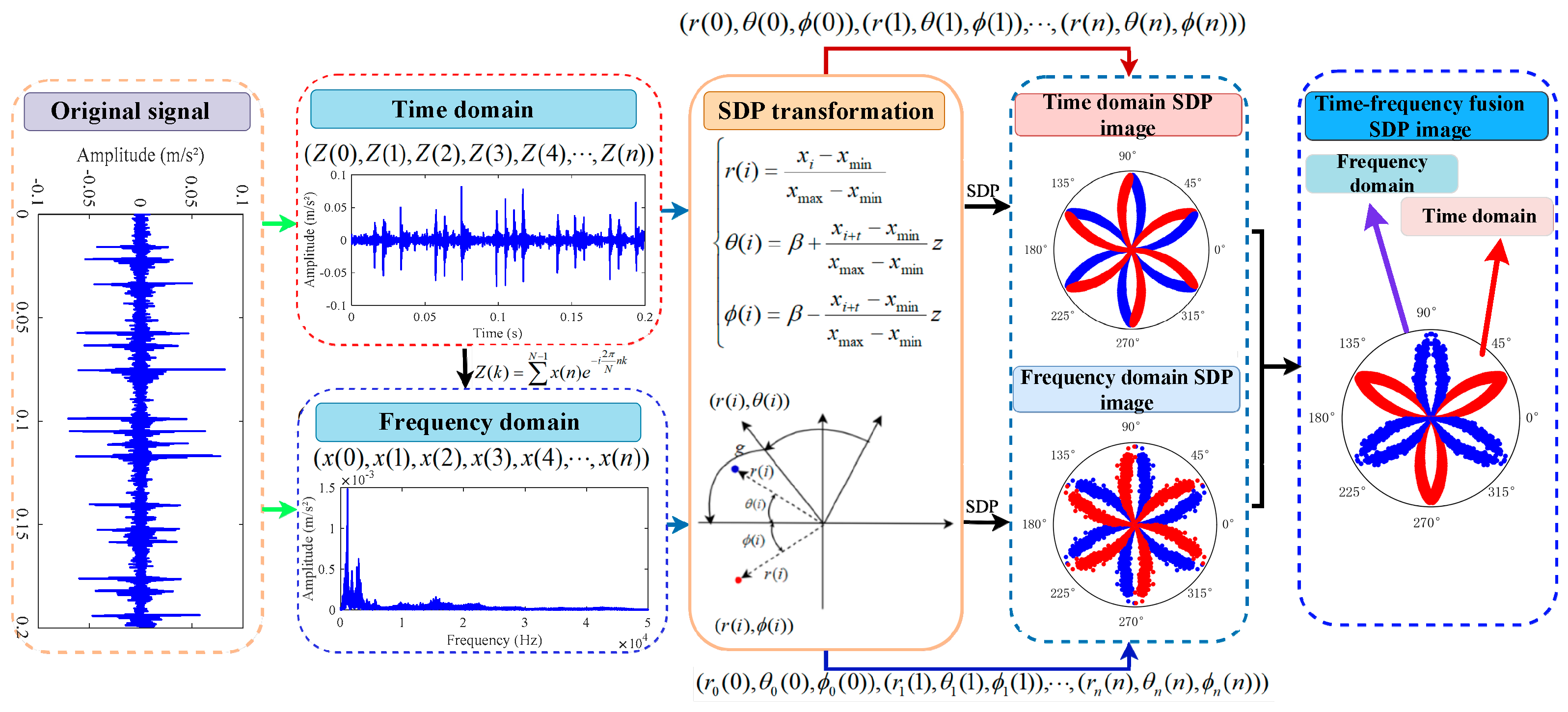
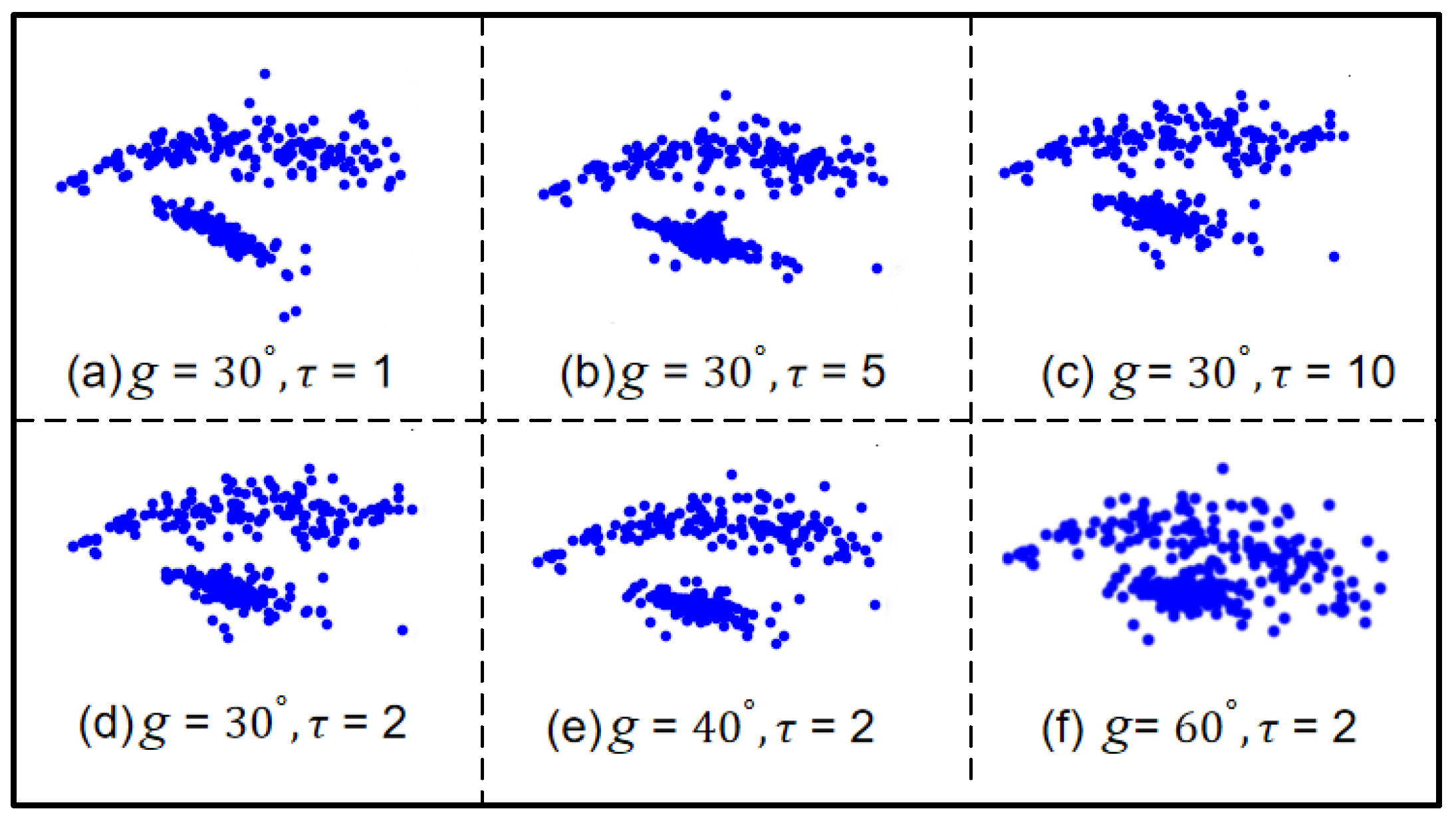
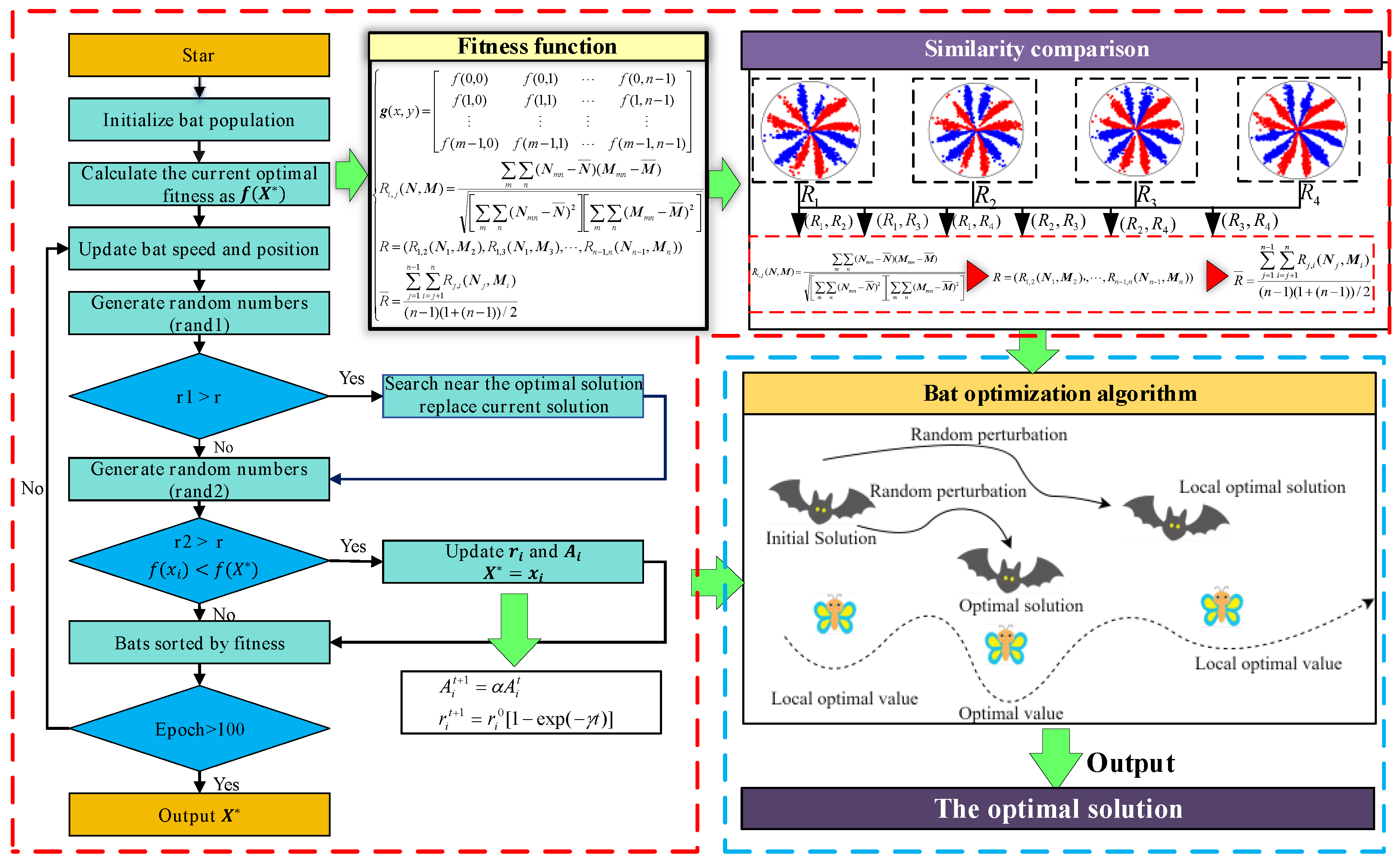
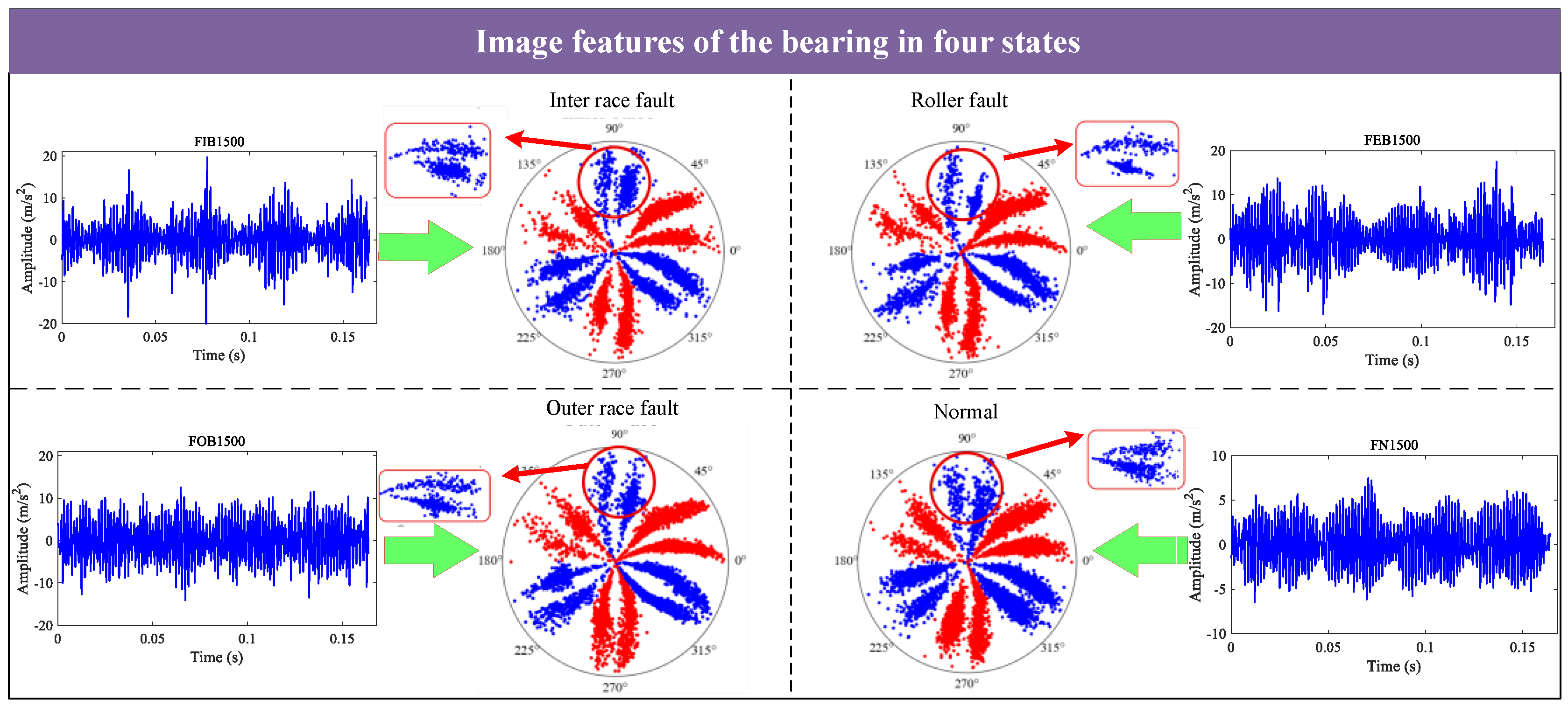
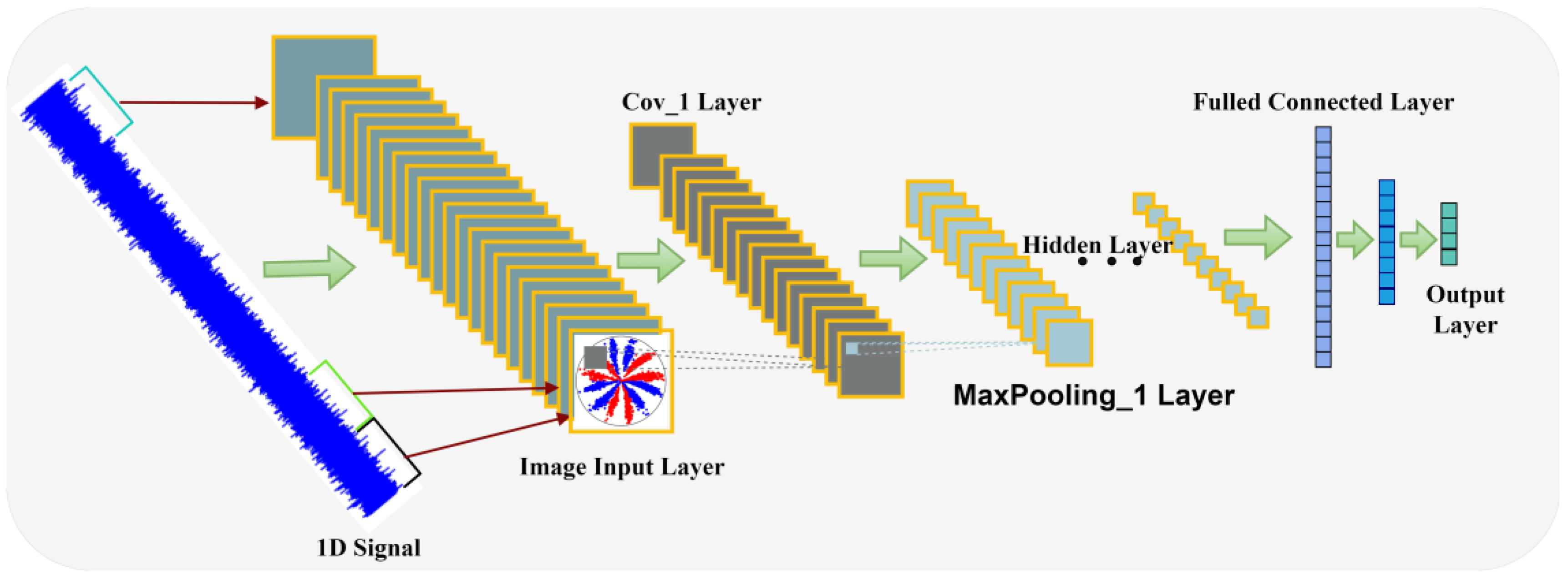
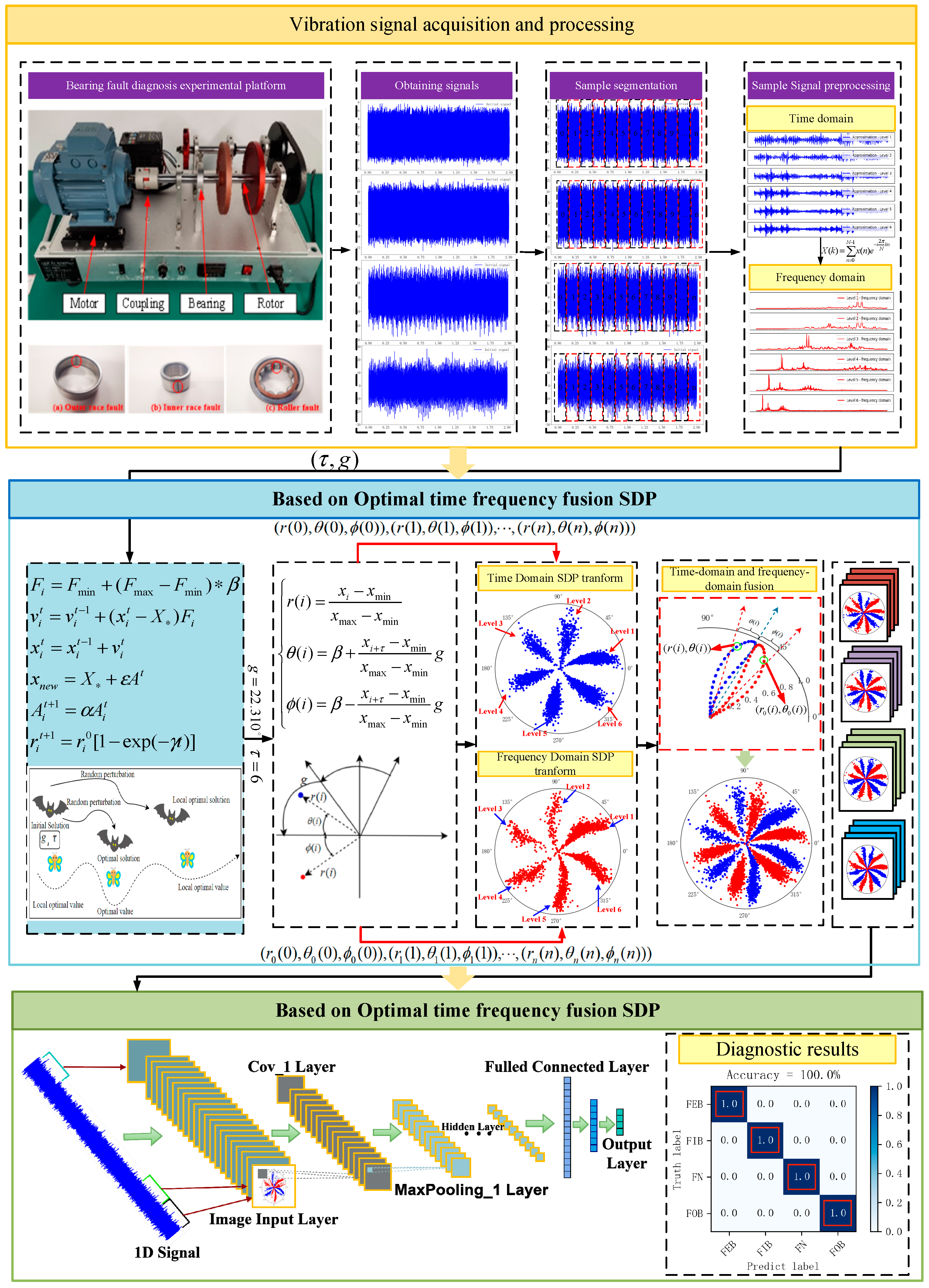
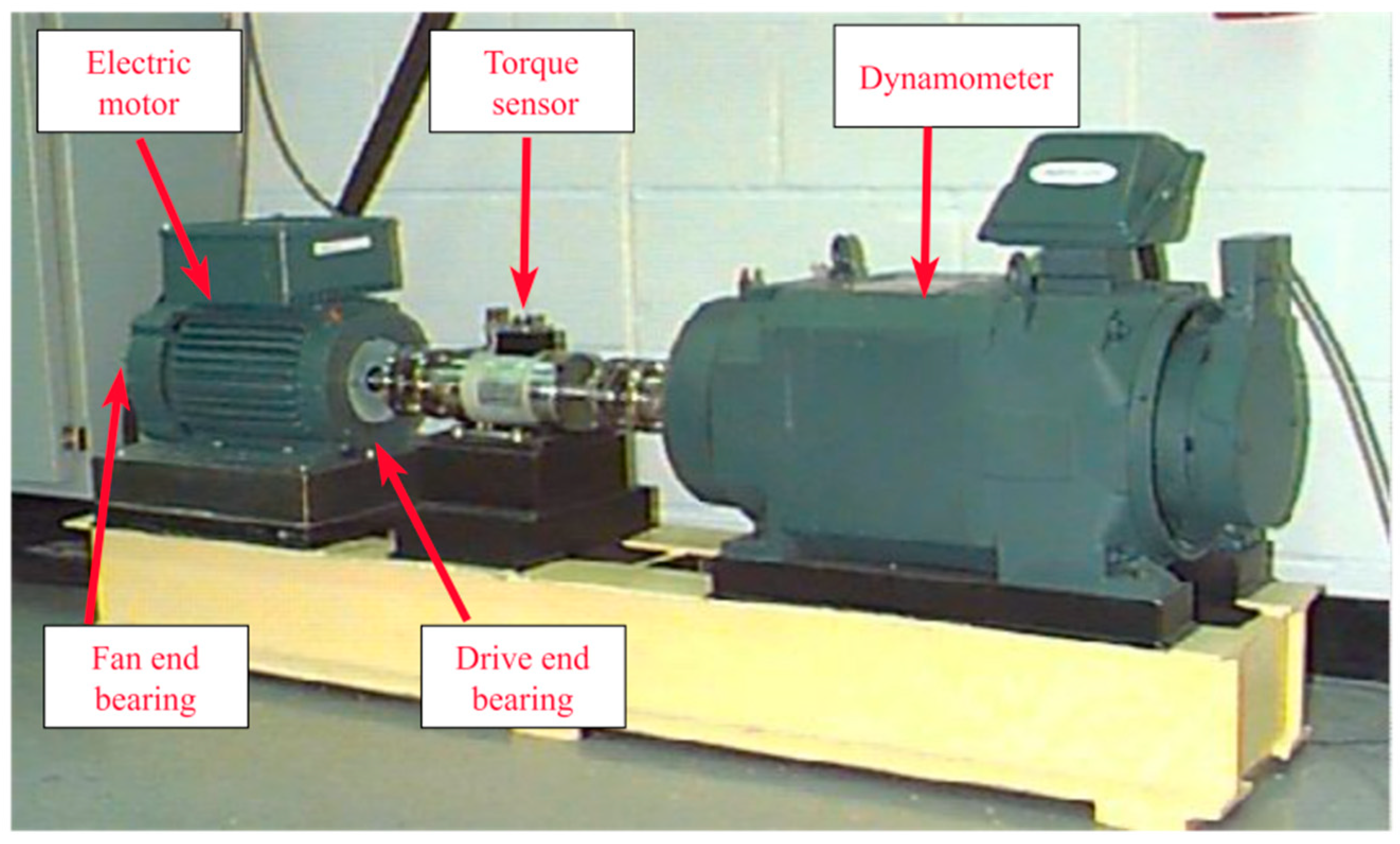

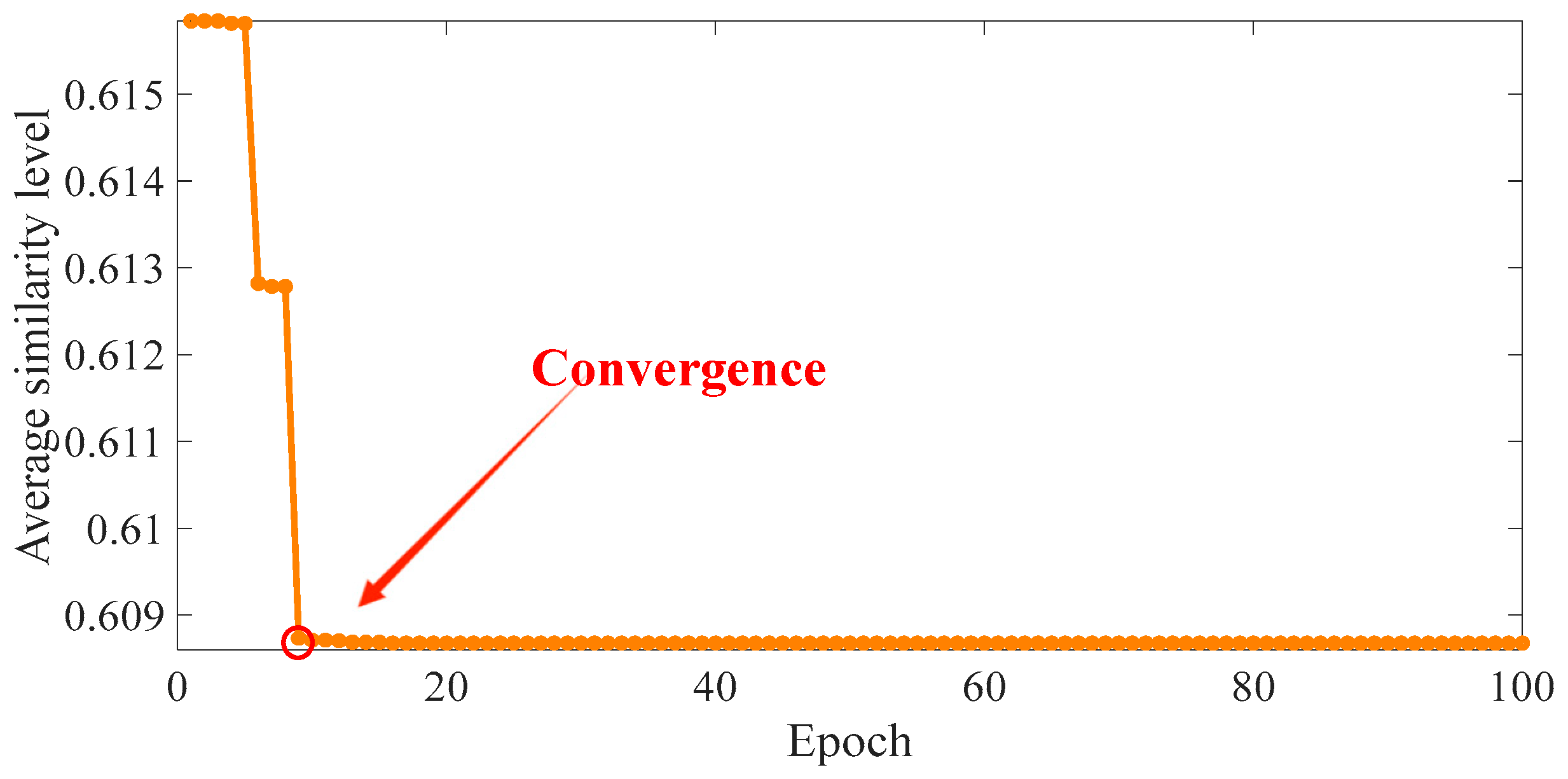

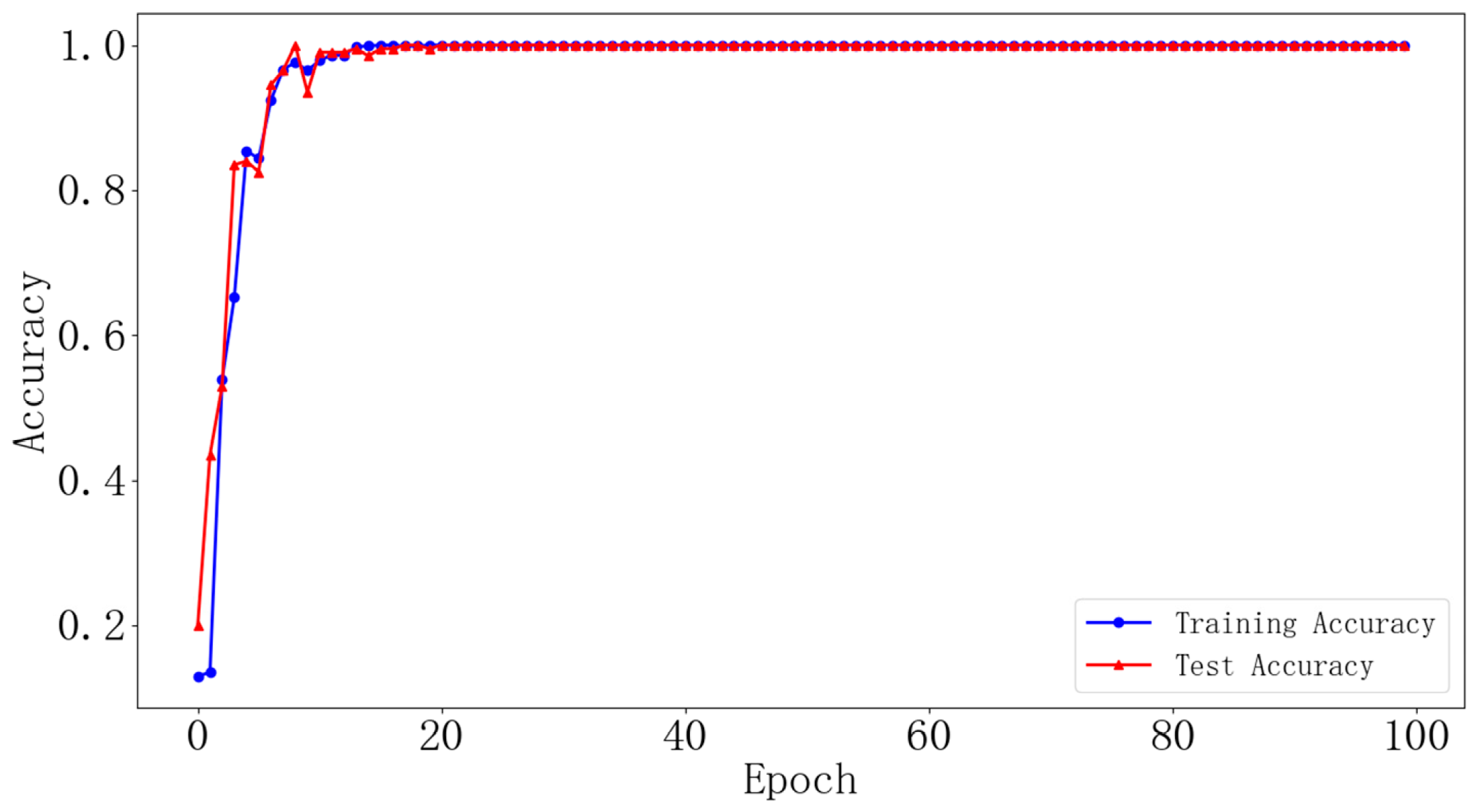
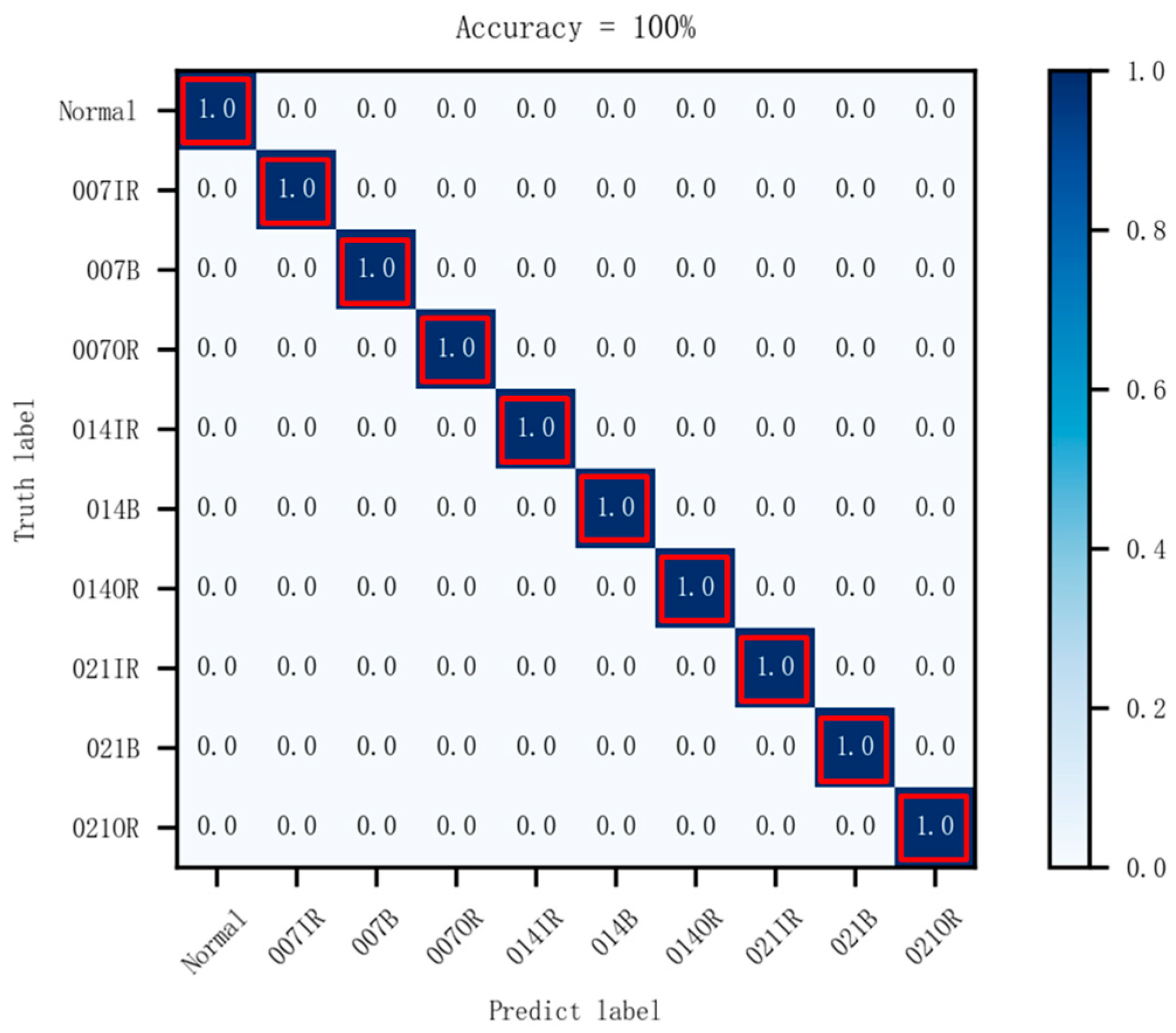
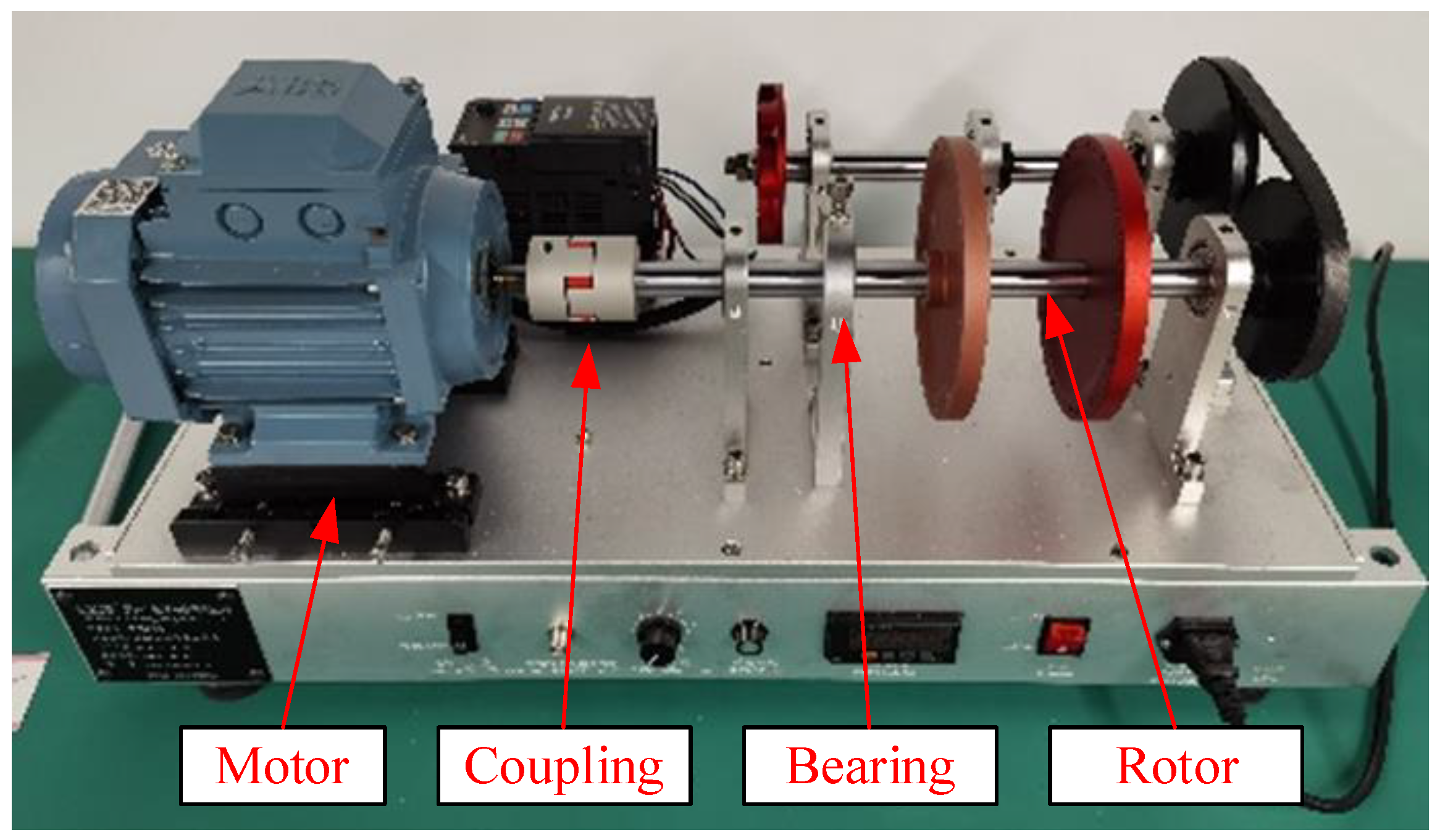

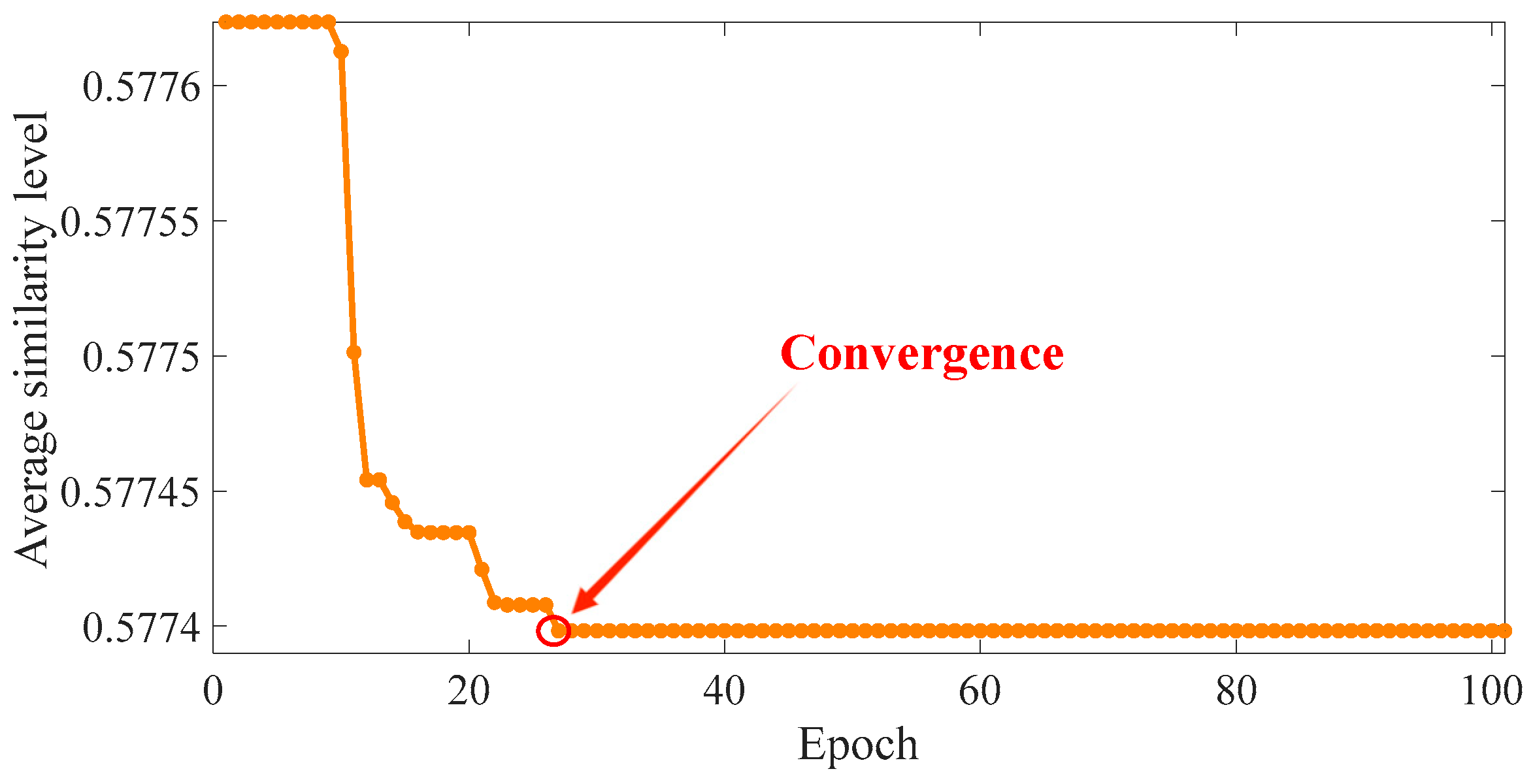

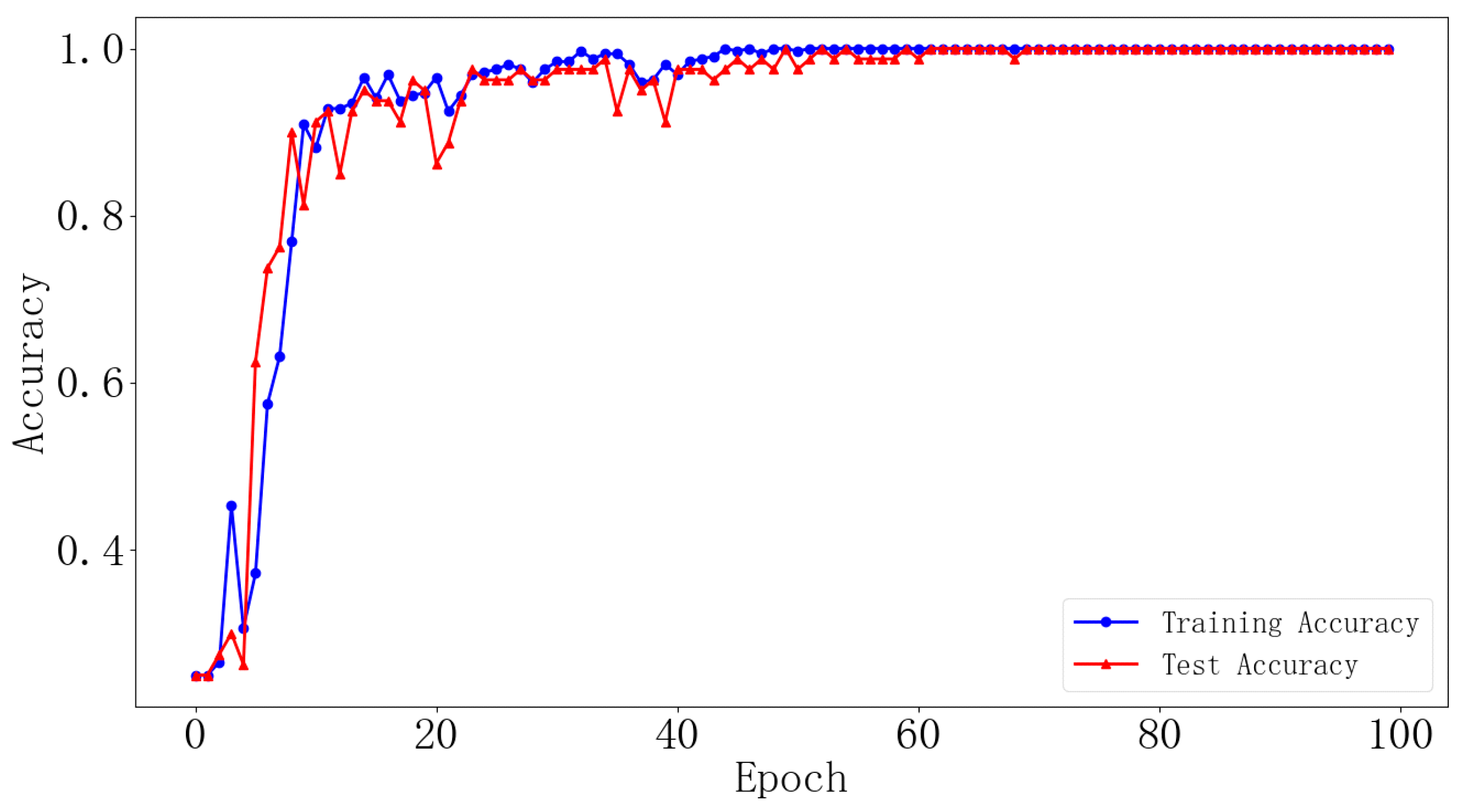

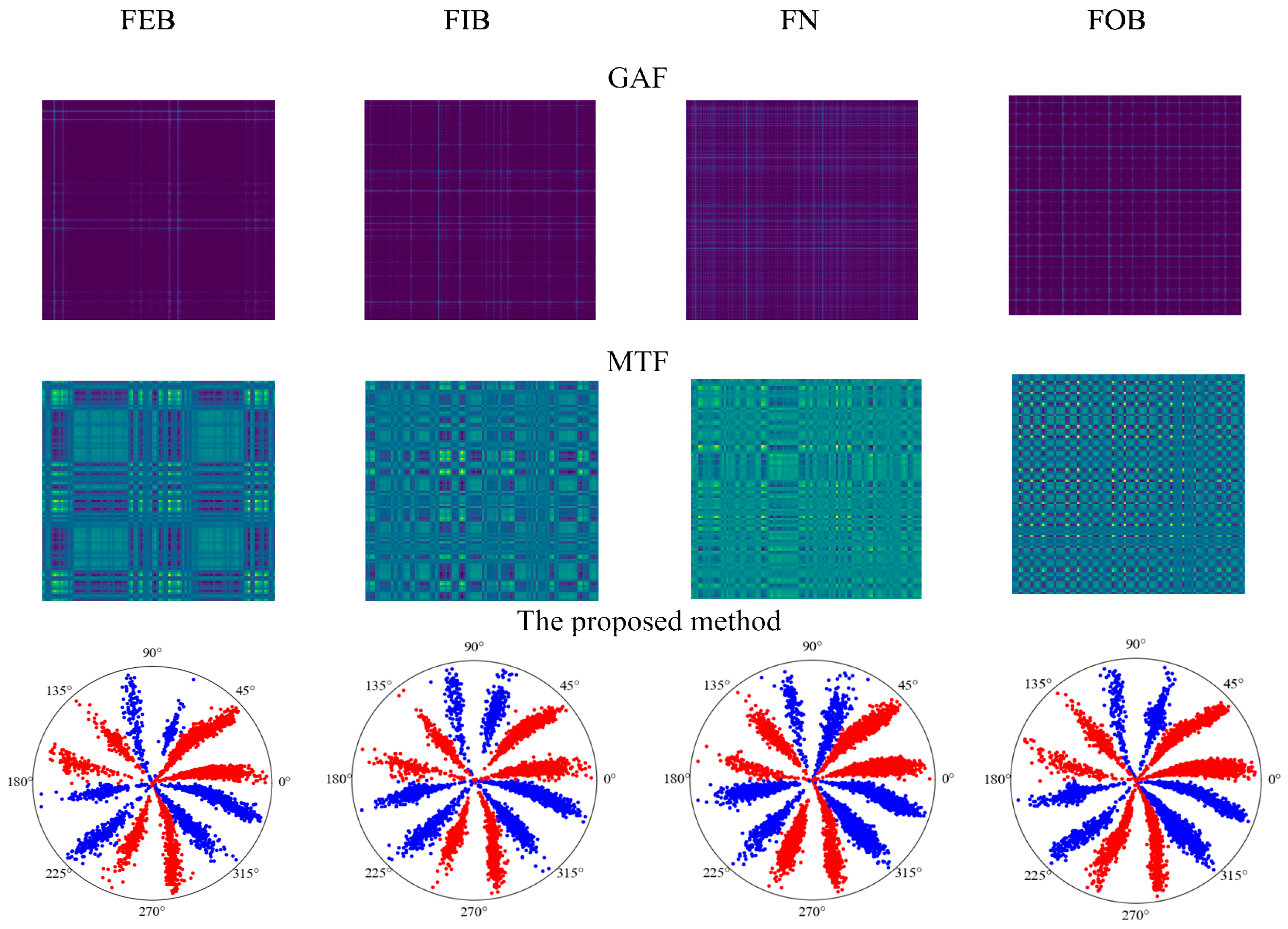

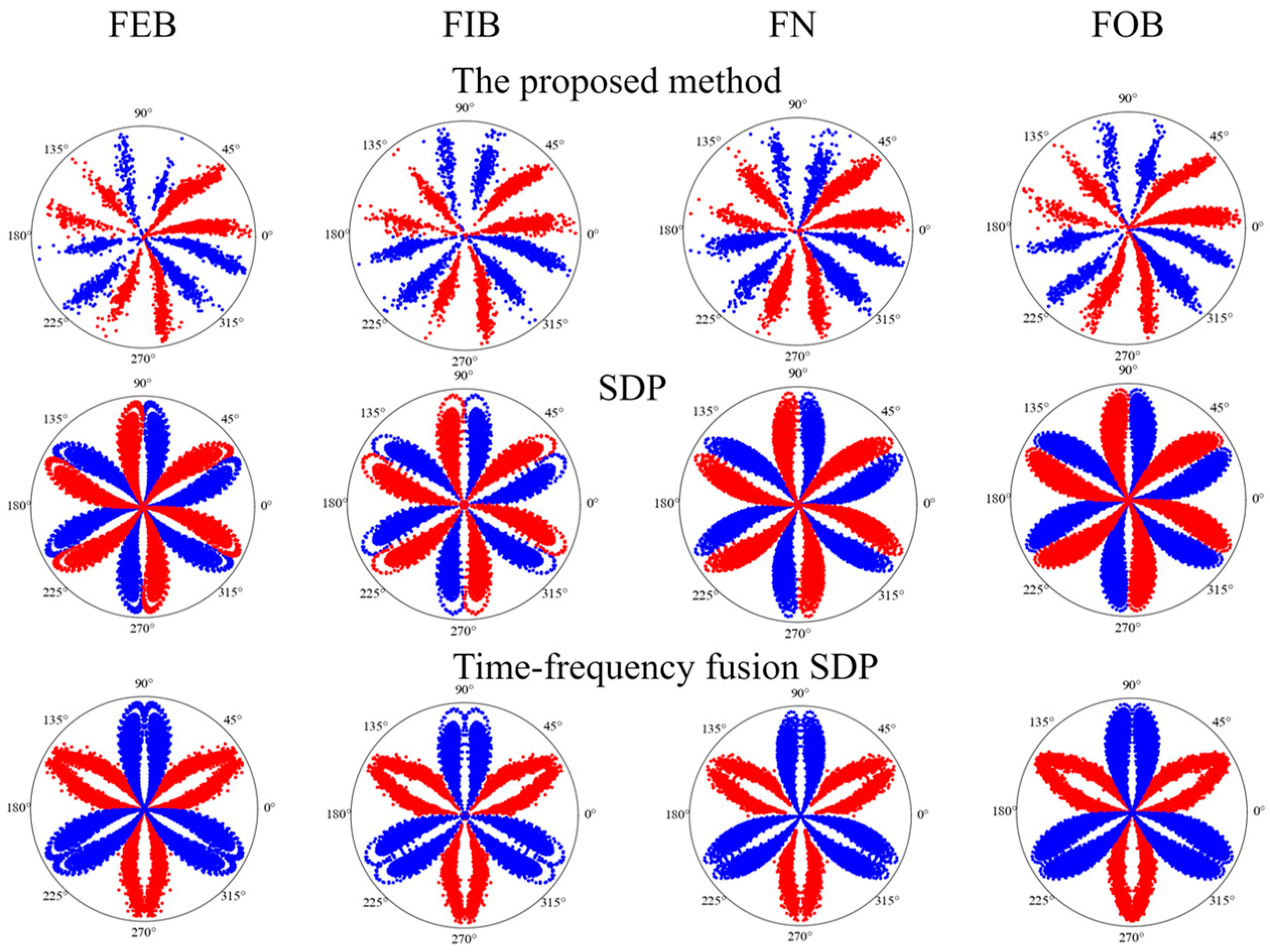

| Bearing State | Fault Diameter (Inches) | Number of Samples | Label |
|---|---|---|---|
| Normal | - | 100 | Normal |
| Inner Race fault | 0.007 | 100 | IR007 |
| Inner Race fault | 0.014 | 100 | IR014 |
| Inner Race fault | 0.021 | 100 | IR021 |
| Roller fault | 0.007 | 100 | B007 |
| Roller fault | 0.014 | 100 | B014 |
| Roller fault | 0.021 | 100 | B021 |
| Outer Race fault | 0.007 | 100 | OR007 |
| Outer Race fault | 0.014 | 100 | OR014 |
| Outer Race fault | 0.021 | 100 | OR021 |
| Bearing State | Number of Samples | Label |
|---|---|---|
| Normal | 100 | FN |
| Outer Race fault | 100 | FOB |
| Inner Race fault | 100 | FIN |
| Roller fault | 100 | FEB |
| Methods | Average Image Transformation Time (s) | Dataset Operation Time (s) |
|---|---|---|
| GAF | 0.692 | 277.070 |
| MTF | 0.381 | 152.519 |
| The proposed method | 0.111 | 44.605 |
| Methods | Classifier | Accuracy (%) | Train Time (s) | Epoch of Reach the Convergence |
|---|---|---|---|---|
| GAF | DCNN | 97.5 | 1326 | 34 |
| MTF | DCNN | 93.8 | 1329 | 36 |
| The proposed method | DCNN | 100 | 265 | 23 |
| Methods | Classifier | Accuracy (%) | Epoch of Reach the Convergence |
|---|---|---|---|
| Time frequency fusion SDP | DCNN | 92.5 | 76 |
| SDP | DCNN | 86.9 | 84 |
| The proposed method | DCNN | 100 | 23 |
Disclaimer/Publisher’s Note: The statements, opinions and data contained in all publications are solely those of the individual author(s) and contributor(s) and not of MDPI and/or the editor(s). MDPI and/or the editor(s) disclaim responsibility for any injury to people or property resulting from any ideas, methods, instructions or products referred to in the content. |
© 2024 by the authors. Licensee MDPI, Basel, Switzerland. This article is an open access article distributed under the terms and conditions of the Creative Commons Attribution (CC BY) license (https://creativecommons.org/licenses/by/4.0/).
Share and Cite
Liang, G.; Song, X.; Liao, Z.; Jia, B. Optimal Time Frequency Fusion Symmetric Dot Pattern Bearing Fault Feature Enhancement and Diagnosis. Sensors 2024, 24, 4186. https://doi.org/10.3390/s24134186
Liang G, Song X, Liao Z, Jia B. Optimal Time Frequency Fusion Symmetric Dot Pattern Bearing Fault Feature Enhancement and Diagnosis. Sensors. 2024; 24(13):4186. https://doi.org/10.3390/s24134186
Chicago/Turabian StyleLiang, Guanlong, Xuewei Song, Zhiqiang Liao, and Baozhu Jia. 2024. "Optimal Time Frequency Fusion Symmetric Dot Pattern Bearing Fault Feature Enhancement and Diagnosis" Sensors 24, no. 13: 4186. https://doi.org/10.3390/s24134186





